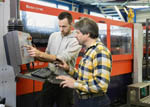19 May 2015
Cloud software maximises sheet metal utilisation
 Toni Räber, joint managing director of AL-Cut AG, a nine-man sheet metalworking subcontractor near Lucerne, Switzerland, is one of the first Bystronic laser profiler users to adopt the manufacturer’s new cloud-based ByOptimizer nesting service. Its purpose is to maximise sheet metal usage and reduce the amount of waste material left in the skeleton.
Toni Räber, joint managing director of AL-Cut AG, a nine-man sheet metalworking subcontractor near Lucerne, Switzerland, is one of the first Bystronic laser profiler users to adopt the manufacturer’s new cloud-based ByOptimizer nesting service. Its purpose is to maximise sheet metal usage and reduce the amount of waste material left in the skeleton.
Bystronic, which is also Swiss, has dedicated a massive amount of computing power at its data centre in Niederönz to number-crunching customers’ data for calculating the optimal nest for producing a given number and shape of components from any size of sheet.
Cutting plans are normally produced at a manufacturer’s premises manually or using either Bystronic’s own BySoft 7 software or a third party’s nesting system. However, ByOptimizer is able to produce much better material utilisation by placing parts more closely together and it does this very quickly. Significantly, it allows effective use of common line cutting, where a single laser path cuts one side of a component and another side of a second component in a single pass.
Machines have been capable of doing this for years. However, without an intelligent cutting strategy, problems can occur due to heat distorting the components, for example, leading to loss of accuracy. For this reason, its adoption has been slow. ByOptimizer changes all that, as AL-Cut’s experience reveals.
One day, Mr Räber received an email asking for 800 parts of complex shape to be cut from 10 mm thick mild steel and delivered the next day. AL-Cut's laser cutting expert, Thomas Seeholzer entered the data into the company’s BySoft software, from where the file was forwarded to the ByOptimizer online service, which is integrated into BySoft to simplify data processing.
At the server, an algorithm was applied to the data to generate a cutting plan. A database incorporating more than 300 parameters provides comprehensive information about cutting processes and the behaviour of different material. Based on this data, ByOptimizer created the ideal cutting plan for the 800 parts.
All relevant aspects were taken into account, including safe cutting paths and feed rates to minimise heat generation around the sheet, the minimum number of piercings necessary per contour, and whether micro joints should be included in the cutting plan so that cut parts initially remain attached to the skeleton.
After 50 minutes, Thomas Seeholzer received the finished cutting plan, on which parts were placed so close to each other that common line cutting was frequently exploited and any gaps were few and small. A considerable amount of space was saved compared with if the job had been nested locally at AL-Cut. The 800 parts were laser-cut from eleven steel sheets instead of 15, a material saving of approximately 30 percent on this job.
Additionally, placing parts so near to each other shortens the cutting path, in this case to less than four hours, so the cycle was finished more quickly and productivity was higher than it would otherwise have been.
Toni Räber concluded, “ByOptimizer speeds the entire workflow, from the quote, which is easier and quicker to calculate accurately, through to optimal grouping of the parts to be cut on the metal sheet, and error-free profiling on the laser. In some cases we have achieved material savings of as much as 50 per cent.”
- Contact Information
- Name: Dave Larcombe
- Email: david.larcombe@bystronic.com
- Website: www.bystronic.com

